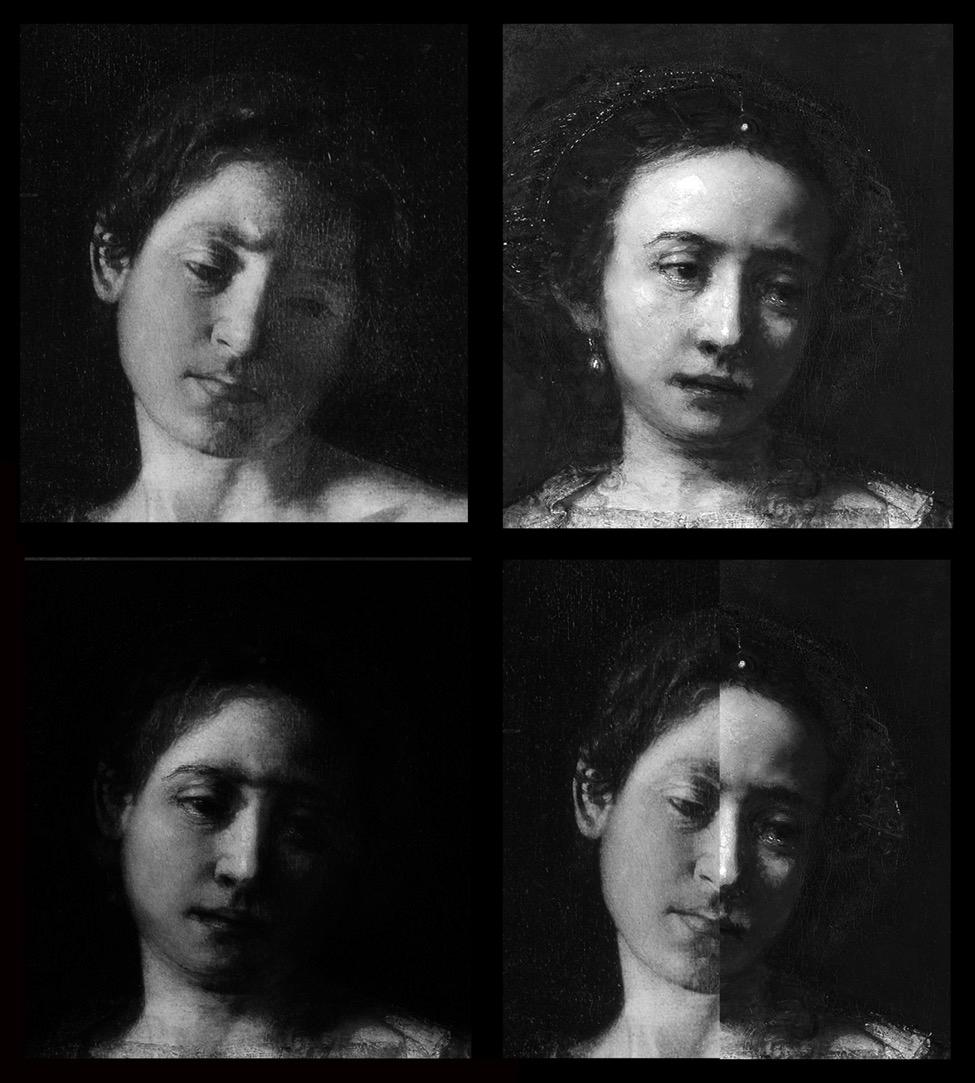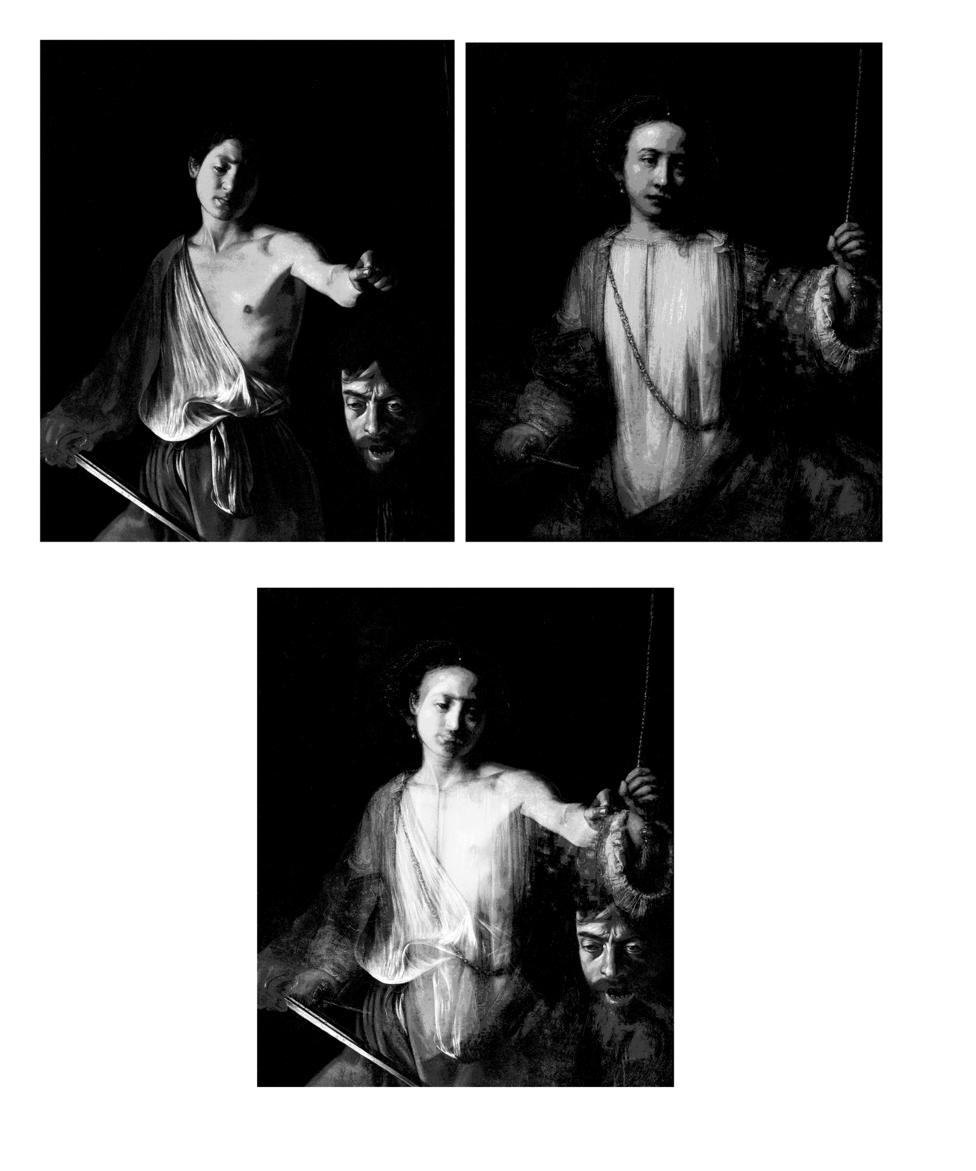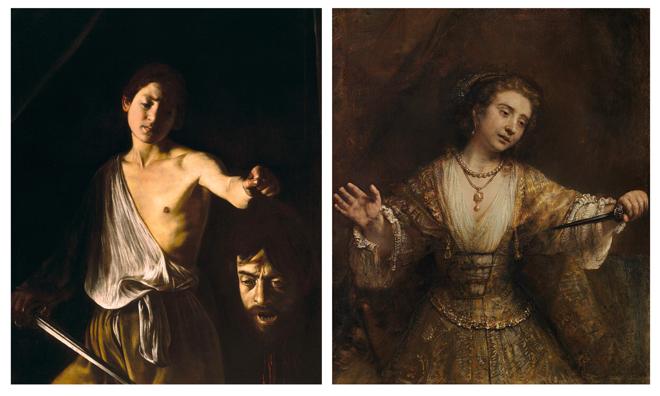
15 minute read
A Matter of Light and Death: Caravaggio’s Direct Influence on Rembrandt's Work

Cover Image: Overlay of David with the Head of Goliath, by Michelangelo Merisi da Caravaggio. c.1 606- 1 607. oil on canvas. 1 25 by 1 01 cm. (Galleria Borghese, Rome), and Lucretia, by Rembrandt van Rijn. 1 666. oil on canvas. 1 05.1 by 92.3 cm. (Minneapolis Institute of Arts, Minneapolis, MN).
A Matter of Light and Death:
Rembrandt’s Minneapolis Lucretia and Caravaggio’s Legacy in the Dutch Master’s Work
Jeremy E. Caniglia
Acknowledgements:
I would like to thank artist James Robinson for his contributions to this work, especially his analysis of Belshazzar’s Feast and Bellona, and C.D. Caniglia for his editing and contributions to this study.
Abstract:
Recent scholarship and exhibitions have unearthed striking connections between the style of the seventeenth century Dutch Masters and the Caravaggisti in Italy1,2,3. While much has been made of Dutch painters’ travels to Italy in the 1600s to view the paintings of Caravaggio and his associates, the idea that Rembrandt van Rijn drew inspiration from Caravaggio has been met with skepticism. Rembrandt never visited Italy4,5 , and his adoption of Italian baroque color palettes and compositional schemes has been widely regarded as an adaptation of their use by Dutch Caravaggisti6,7. Nonetheless, many of Rembrandt’s paintings use compositions and poses familiar to those who study Caravaggio. By historical contextualization and painterly analysis, expanding upon a connection first made by Michael Hirst in 19688, we examine the reasons behind striking similarities between Rembrandt’s Lucretia (1666) and Caravaggio’s Borghese David with the Head of Goliath (here dated 1606, following analysis by Friedlaender and Vodret9,10). We establish that Rembrandt must have been familiar with (even, perhaps, in possession of) a painted copy or drawing of Caravaggio’s David with the Head of Goliath. We also contextualize the 1666 Lucretia within Rembrandt’s oeuvre and consider the implications of this previously unidentified influence on contemporary views of his work.
Figure 1: Left Portrait of the Italian Painter Michelangelo Merisi da Caravaggio, by Ottavio Leoni. c. 1621. chalk on paper. 23.4 by 16.3 cm. (Biblioteca Marucelliana, Florence). Right Crop of Self-Portrait, by Rembrandt van Rijn. 1659. oil on canvas. 84.5 by 66 cm. (National Gallery of Art, Washington, D.C.).

Introduction:
Recent scholarly works, and exhibitions such as the Dutch Masters exhibit at the Metropolitan Museum of Art in New York11, have showcased connections between the Dutch Masters of Rembrandt’s time and Caravaggio’s tenebrist followers in Italy. While many Dutch painters traveled to Italy to view paintings by Caravaggio (among many others) in the early seventeenth
1 W. Liedtke: ‘Rembrandt (1606-1669): Paintings.’ The Metropolitan Museum: Heilbrunn: Timeline of Art History. (2003), n.p. 2 V. Manuth: ‘Michelangelo of Caravaggio, who does wondrous things in Rome: On Rembrandt’s knowledge of Caravaggio.’ Rembrandt/Caravaggio. 2 (2006), pp.180-194. 3 M. van Eikema Hommes and E. van de Wetering: ‘Light and colour in Caravaggio and Rembrandt, as seen through the eyes of their contemporaries.’ Rembrandt/Caravaggio. 1 (2006), pp.164-179. 4 W. Liedtke, ‘Rembrandt (1606-1669): Paintings.’ (2003), n.p. 5 E. van de Wetering: Rembrandt: The Painter Thinking, Amsterdam 2016, pp.15-17. 6 E. van de Wetering, ‘Rembrandt: The Painter Thinking.’ (2016), pp.15-17. 7 V. Manuth, ‘Michelangelo of Caravaggio.’ (2006), pp. 180194. 8 M. Hirst: ‘Rembrandt and Italy.’ The Burlington Magazine. 110(781) (1968), pp.221-223. 9 W. Friedlaender: Caravaggio Studies, Princeton, NJ 1974, p. 119. 10 R. Vodret: ‘David with the Head of Goliath,’ Caravaggio: Works in Rome, Technique and Style, Vol. II. 21 (2016), p.655. 11 Open source

Figure 2: Top Left David with the Head of Goliath, by Michelangelo Merisi da Caravaggio. c.1606-1607. oil on canvas. 125 by 101 cm. (Galleria Borghese, Rome). Top Right Lucretia, by Rembrandt van Rijn. 1666. oil on canvas. 105.1 by 92.3 cm. (Minneapolis Institute of Arts, Minneapolis, MN). Bottom Highlighting of key contours in Lucretia. Note that creases in Lucretia’s robes, which, in the top right, appear to have been painted before the yellow robe (while higher-contrast black marks visible in the same area would have been painted after). These contours highlight David’s figure.
with the Head ofGoliath. Rembrandt did not need to travel to Italy to immerse himself in the tradition of the Caravaggisti; he was surrounded by it46 . This underscores the importance of the 1666 Lucretia’s relationship to the Borghese David with the Head ofGoliath, which seems the culmination in a long-standing Caravaggist impulse in Rembrandt’s work.
Analysis:
An in-depth expansion upon Hirst’s analysis47 , with the intent of establishing a definitive compositional continuity between the Borghese David with the Head of Goliath and the 1666 Lucretia, must begin with the faces of Caravaggio’s David and Rembrandt’s Lucretia. David is depicted with his head at a slight angle, tilted towards his left shoulder. Lucretia’s head is placed in the same position (Figure 3). The proportions of both heads are nearly identical as well. The most peculiar similarity is the feminizing of David’s face in Lucretia’s. The models portrayed in both paintings possess nearidentical characteristic facial features. For instance, the eyes of both David and Lucretia are caught in a melancholic gaze, looking outward towards their raised left hands. Both sets of eyes have heavy lids and glossy white highlights that suggest wet tears. Rembrandt paints Lucretia with a high, bare forehead, thick eyebrows, rounded cheek bones, and thick upper and lower lips; these features are all present in Caravaggio’s David. The shape of both figures’ noses is identical as well. To construct the unknown model for Lucretia48, all that is necessary is to place earrings on Caravaggio’s David and add a halo feature outside her first circle of hair. The placement of shadows in Rembrandt’s Lucretia, across the face and the body, also matches the pattern in Caravaggio’s David.
46 D. Hammer-Tugendhat. The Visible and the Invisible: On Seventeenth-Century Dutch Painting. De Gruyter: Boston, 2015. p. 77. Figure 3: Top Left Head of David in David with the Head of Goliath, by Michelangelo Merisi da Caravaggio. c.1606-1607. oil on canvas. 125 by 101 cm. (Galleria Borghese, Rome). Top Right Head of Lucretia in Lucretia, by Rembrandt van Rijn. 1666. oil on canvas. 105.1 by 92.3 cm. (Minneapolis Institute of Arts, Minneapolis, MN). Bottom Left Overlay of David and Lucretia’s heads, illustrating their resemblance. Bottom Right David on left, Lucretia on right, showing continuity between key facial features from one painting to the other, particularly the lips and nose.

Another clue suggesting David as Lucretia’s model comes from David’s right arm, which holds his sword. This area is the weakest modeling point in Caravaggio’s composition. He hides the fact that the arm and hand are placed awkwardly by letting David’s right arm fall into shadow so that only the right hand’s knuckles and fingers, holding the sword, are clearly visible. Rembrandt seems also to have been confused as to the layout and modeling of the right arm of Lucretia, whose right arm holds the dagger that she has just thrust into her chest. His placement of the arm and hand (particularly in outlines of what appears to be its original position, further to the edge of the canvas) are again almost identical to Caravaggio’s (Figure 4). Had Rembrandt had time to paint from a real model, he could have sorted out the arm’s proper placement in space. Instead, he overlaid Lucretia’s arm on precisely
47 M. Hirst, Rembrandt and Italy.’ (1968), pp.221-223. 48 S. Schama. ‘Rembrandt’s Eyes. ’ (1999). pp.660-661.
the same area of canvas occupied by David’s in Caravaggio’s painting.
Figure 4: Top Left David with the Head of Goliath, by Michelangelo Merisi da Caravaggio. c.1606-1607. oil on canvas. 125 by 101 cm. (Galleria Borghese, Rome). Top Right Lucretia, by Rembrandt van Rijn. 1666. oil on canvas. 105.1 by 92.3 cm. (Minneapolis Institute of Arts, Minneapolis, MN). Bottom Overlay of the two paintings, showing striking figural similarities. Note that Lucretia’s garments perfectly cloth David’s figure. Images in black and white for contrast.

Even the dagger in her right hand protrudes at exactly the same angle as David’s sword. The distinct round hand guard, spacer, and blade are foreshortened, with the highlight catching the lower part of both David’s sword and Lucretia’s dagger. The awkward modeling of Lucretia’s right hand showcases Rembrandt’s confusion concerning how to exactly copy what he sees in David’s hand holding the sword. Lucretia’s little finger looks unnaturally long, as does her ring finger. The hand’s foreshortening looks unrealistic, which is explained if Rembrandt was working from a copy and not a model in his studio. Rembrandt decided to move Lucretia’s right hand slightly closer to her body so that her dagger breaks her dress’ plane in the shaded area of the right hip, emphasizing the blade’s highlight and
49 S. Schama. ‘Rembrandt’s Eyes. ’ (1999). p.663. bringing the viewer’s eye back into the composition. While the final positioning of the arm does not match David’s exactly, it should be noted that this highlighting was used by Caravaggio with David’s sword.
Another match is found in the sash slung over Lucretia’s right shoulder, which extends down to the left side of her waist, across her blood-stained blouse. This sash mimics the positioning of David’s rugged, rag-tied half-shirt, the upper edge of which travels across his entire chest in the same placement (Figure 4). The blood stain of Lucretia’s wound overlays with the knot in David’s shirt. Rembrandt also makes a conscious decision to leave Lucretia flat-chested, presumably to more closely resemble David’s physique and to facilitate his mimicking of the chest’s movement in Caravaggio’s David. This exposes more of Lucretia’s left side and wound to the viewer. Caravaggio creates the same effect for a viewer’s eyes, which are directed towards Goliath’s head, with highlights on David’s chest. It is particularly striking that Rembrandt seems to have only added a slight shadow below where Lucretia’s breasts should have been to indicate their presence. This small gesture conceals the fact that her figure is in fact that of Caravaggio’s David, and not a model.
Lucretia’s broad thighs and hip placement both clearly overlay with David’s as well. The movements in her drapery have the same contours as those in Caravaggio’s David, and her left hip structure is identical to David’s (Figure 2). The right hip is depicted in an awkward position in both paintings, with the express purpose, in each, to highlight the blade, which crosses over the top of the right leg in the foreground of both compositions.
The most telling point in Rembrandt’s composition is Lucretia’s left arm, raised in the same position as David’s and grasping a cord which will open the concealing curtains of a canopy bed49. Instead of Goliath’s head placed below the arm he creates a sphere, where the
longtime admiration, rather than an unusual oneoff.
The motif of a foreshortened, outstretched arm to which a figure’s gaze is directed, paired with a lowered arm near the hip in the Borghese David with the Head of Goliath is rendered with what must have been, at the time of its painting, unprecedented emotional weight. Though variations of the pose crop up in other artists’ work, both the frequency with which it is used by Rembrandt and the degree to which is directly adapted from Caravaggio’s David for Rembrandt’s Lucretia suggest that David with the Head of Goliath was a stronger influence on the Dutch master’s art than has previously been identified.
Numerous Rembrandt paintings invoke a figure gazing over an outstretched left arm, with lowered right arm and a sash (or similar object) strung from right shoulder to left hip. Bellona (1633), who also grasps a Medusa shield that calls to mind both Rubens and Caravaggio, is not portrayed from the same angle as David but nonetheless adapts his pose. Particularly noteworthy is a mirrored depiction in Aristotle with a Bust of Homer (1653). In it, Aristotle gazes over an outstretched right hand while lowering his left to his hip and wearing a chain that cuts across his chest. Of note is the fact that Aristotle, like David, gazes towards a head while apparently contemplating life, death, and time. A master of inverting images, Rembrandt could easily have taken a cue from the Borghese David with the Head of Goliath’s composition here. A similar case could be made with regard to the Metropolitan Museum’s Flora (ca. 1654), who is also clad in a shirt similar to Lucretia’s.
Perhaps the simplest comparison, though, at least from a figural standpoint, can be made to Belshazzar’s Feast (1635) (Figure 5). Belshazzar looks over an outstretched left hand, appearing but for an apparition to be ready to grip a servant’s head by the hair much as David holds Goliath’s. The right arm is lowered at about the same angle as David’s; it is almost possible to imagine a sword in it. A chain runs across the length of Belshazzar’s chest, and hist coat obscures his right arm as darkness obscures David’s. Though not anatomically exact, Rembrandt’s rendering certainly incorporates noteworthy elements of the Borghese David with the Head of Goliath.
Figure 5: Left Belshazzar’s Feast, by Rembrandt van Rijn. 1635. oil on canvas. 167.6 by 209.2 cm. (National Gallery, London). Right David with the Head of Goliath, by Michelangelo Merisi da Caravaggio. c.1606-1607. oil on canvas. 125 by 101 cm. (Galleria Borghese, Rome). Note especially the position of the fingers on the right hand, the direction of the figure’s gaze over the left arm, and the head beneath the left hand.

Other works, though less conspicuous, speak to the influence of David’s pose on Rembrandt. Examples are plentiful, but the positioning of Mordecai in The Triumph of Mordecai (1641), and of Juno’s arms in Juno (1661-1665) serve as two of note. Even the figure of Frans Banning Cocq in The Night Watch, or Militia Company of District II under the Command of Captain Frans Banning Cocq (1642), which is marked by a gaze over an outstretched left arm, a sash from right shoulder to left hip, and a lowered right arm (holding a cane instead of a sword) brings to mind Caravaggio. While other artists have used the David motif, Rembrandt seems to have adopted it with particular zeal, and the shear number of his paintings in which David’s pose can be identified speaks to a direct Caravaggist influence on his works long before the 1666 Lucretia.
Such a longstanding attachment to the composition of the Borghese David with the Head of Goliath makes chronological sense. If Rembrandt’s familiarity with the painting came from the existence of a copy by Finson (or even one by Honthorst), his first exposure to the work would have occurred in the 1620s. Rembrandt
work by Caravaggio89. The role of Pieter Lastman in appraisals of apparent Caravaggio paintings in Finson and Abraham Vinck’s possession seems to be poorly understood, given that the influence of his association with Finson and housemate Vinck on his assessments (several of the paintings he identified as Caravaggio’s have later had their authenticity called into question) is not known90. A more thorough investigation of any connections between Lastman, Finson, and de Bruyn could uncover information about an important pathway for the transmission of artistic ideas between Naples and Amsterdam that seems, at the present, to have been described only in parts.
Notes:
* Figure 6 from footnote on Page 10:
Figure 6: Top Left David with the Head of Goliath, by Michelangelo Merisi da Caravaggio. c.1606-1607. oil on canvas. 125 by 101 cm. (Galleria Borghese, Rome). Top Right Mirrored image of Lucretia, by Rembrandt van Rijn. 1664. oil on canvas. 120 by 101 cm. (National Gallery of Art, Washington, D.C.). Obviously the figures here are not the same. The line above the head to the left of the canvas, which stretches down to the right hand, is visible in both pieces, however, as is some drapery in the upper right hand corner. The gaze above the left hand is also a key feature in both pieces. It should also be noted that the canvas sizes are almost identical.

** It may also be worth noting that David’s body position is adapted in a variety of other Rembrandt paintings, with varying degrees of similarity. Some examples are given in Figure 7:
Figure 7: Top Left Bellona, by Rembrandt van Rijn. 1633. oil on canvas. 127 by 97.5 cm. (Metropolitan Museum of Art, Friedsam Collection, New York). Note especially the darkened right arm, the implied position of the left arm, and the sash strung from right shoulder to left hip. Top Right Mirrored image of Juno, by Rembrandt van Rijn. c.1661-1665. oil on canvas. 127 by 107.5 cm. (Armand Hammer Collection, Los Angeles), illustrating the lowered right and foreshortened left arm. Bottom Left Aristotle with a Bust of Homer, by Rembrandt van Rijn. c.1653. oil on canvas. 143.5 by 136.5 cm. (Metropolitan Museum of Art, Lehman Collection, New York). A mirror image of this painting brings the positions of the arms into greater connection with those in Caravaggio’s David with the Head of Goliath. Attention should be drawn, however, to the figure’s gaze, just above his right hand (below which is a human head), and the golden sash extending from right shoulder to left hip. Bottom Center Self-Portrait with Plumed Cap and Lowered Sabre, by Rembrandt van Rijn. 1634. etching. 19.7 by 16.3 cm. (Rijksmuseum, Amsterdam). Bottom Right Cropped image of Mordecai from The Triumph of Mordecai, by Rembrandt van Rijn. 1641. 17.5 by 21.5 cm. etching and drypoint. (Multiple Collections).

As with the 1664 Lucretia, the figures in Bellona and Juno are three-quarter portraits painted on canvases almost identical in size to that on which the Borghese David with the Head of Goliath is rendered.
89 M. Labarbe, et. al. ‘Caravaggio: Judith and Holofernes,’ (2019). pp. 1-55.
90 V. Manuth, ‘Michelangelo of Caravaggio.’ (2006), p. 183.

